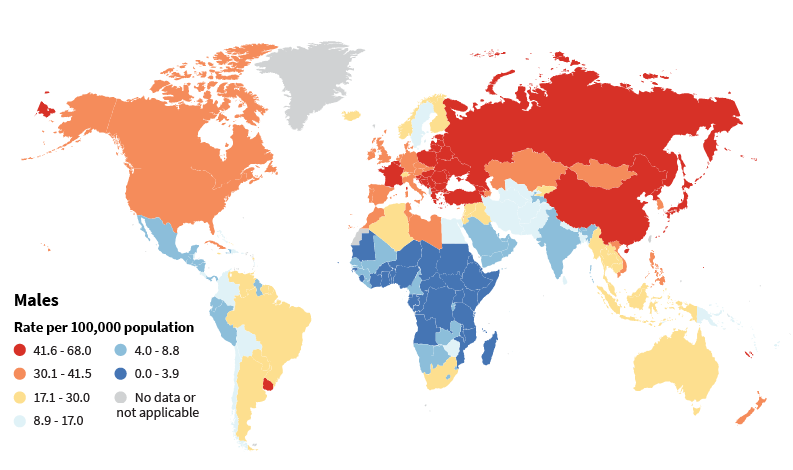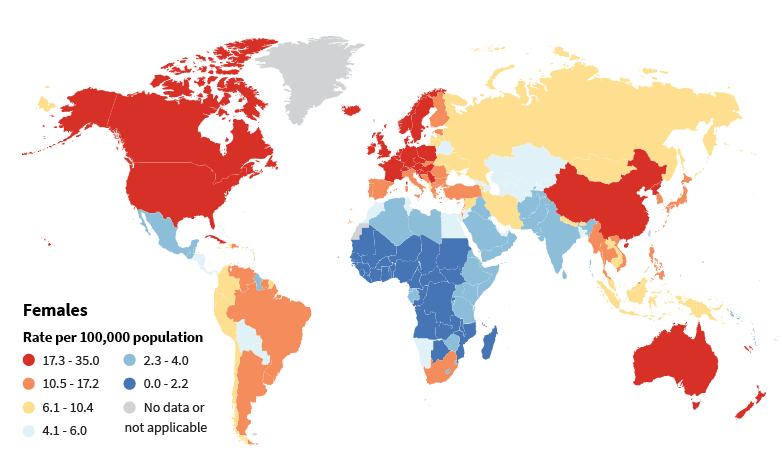Lung Cancer Kills More People Worldwide Than Other Cancer Types
Smoking causes almost 7 of every 10 deaths from lung cancer in men and women across the world.
In 2022 (the year with the most up-to-date information), lung cancer was responsible for:
- About 1 in 8 newly diagnosed cancers worldwide (almost 2.5 million new cases, which is about 12% of all new cases of cancers diagnosed in the world)
- About 1 in 5 deaths from cancer (about 1.8 million deaths, which is about 19% of all cancer deaths in the world)
Tobacco remains the main cause of lung cancer. Only about 3 out of every 10 lung cancer cases are attributable to causes other than tobacco smoking.
The difference in lung cancer incidence and death across countries reflects smoking prevalence. Differences in lung cancer incidence and death rate are related to a country’s historic patterns of tobacco use, including how many people smoke, how long people smoke, how many cigarettes they smoke a day, and their degree of inhalation.
These statistics are according to the most recent American Cancer Society (ACS) Global Cancer Facts & Figures 5th Edition based on 2022 estimates from the International Agency for Research on Cancer (IARC). ACS researchers Hyuna Sung, PhD, Chexi Jiang, MPH, Rebecca Siegel, MPH, and Ahmedin Jemal, DMV, PhD, contributed to the report. An accompanying article from a collaboration with IARC researchers, “Global Cancer Statistics, 2022,” was published in the ACS flagship journal CA: Cancer Journal for Clinicians.
For men across the world, lung cancer was the most commonly diagnosed cancer and the most common cause of death from cancer.
In 2022, for every 7 men who received a new diagnosis of cancer, 1 man was diagnosed with lung cancer (14.3%). The incidence rate for lung cancer in men is about 2x higher than the rate in women, with 32 cases for every 100,000 men compared with 16 cases for every 100,000 women.
Differences in Lung Cancer Incidence Rates Worldwide in Males, 2022

Countries in red on this map (including much of Europe, Russia, China, and Japan) had the highest lung cancer incidence rates in men in 2022. Men in the United States (orange), along with men in several European countries, Libya, Mongolia, and others had the 2nd highest rates of lung cancer. The fewest men diagnosed with lung cancer (dark blue) were largely in sub-Saharan Africa.
Lung cancer was the most frequently diagnosed cancer for men in 33 countries. The highest lung cancer incidence rates in men were in Hungary, Serbia, Bulgaria, and Turkey.
Lung cancer is the leading cause of death for men in 89 countries due to its high fatality rate. The authors note that the areas of biggest concern are in countries among those with the highest populations where the daily smoking prevalence among men is also highest—like Indonesia and China.
For women across the world, lung cancer was the 2nd most commonly diagnosed cancer and the 2nd most common cause of death from cancer.
Lung cancer was the most commonly diagnosed cancer for women in China and North Korea. Hungary was the country with the #1 highest national incidence of lung cancer in women.
Differences in Lung Cancer Incidence Rates Worldwide in Females, 2022

Countries in red on this map (including Canada, the United States, China, Australia, New Zealand, and most of Europe) had the highest lung cancer incidence rates in women in 2022. Women with the 2nd highest incidence rates of lung cancer (orange) were in much of South America, several countries north of the Mediterranean Sea, South Africa, Vietnam, the Philippines, and Japan. The region with the overall fewest women diagnosed with lung cancer (dark blue) were largely in sub-Saharan Africa.
Lung cancer patterns generally reflect how popular smoking is. However, in populations with lower smoking prevalence, other factors are involved. For example, fewer women smoke in China compared to those who do in the US, yet the incidence rate is the same in both countries—30 cases for every 100,000 people. Studies have shown that the cancer burden in China may partly be due to exposure to outdoor air pollution and the burning of solid fuels for heating and cooking at home, as well as exposures to second smoking.
Lung cancer is the leading cause of death for women in 23 countries, predominantly high-income Western countries and China. In certain high-income countries—Denmark, Iceland, Sweden, and the United States—lung cancer death rates in young women approach or surpass those in men.
Research has shown that screening for lung cancer reduces lung cancer mortality in heavy smokers, but so far, few countries have adopted screening guidelines.
It’s hard to get doctors to recommend people for screening and it's also hard to get people to a screening appointment. Plus, the costs can be prohibitive, and some countries don’t have the infrastructure to get the right equipment or manage the screening process. Even screening rates in wealthy countries are low.
Here's the status of lung cancer screening in high-income countries.
The United States
The US Preventive Services Task Force recommends lung cancer screening every year with low-dose computed tomography for people 50 to 80 years old who have a 20-pack-year smoking history.
The American Cancer Society (ACS) recently relaxed the lung cancer screening guideline to help more people be eligible for screening. The new guideline recommends screening for people who currently smoke or who quit within the past 15 years.
Australia
Australia is planning to start a national lung cancer screening program by 2025 for smokers and former smokers.
Europe
The European Commission (the European Union’s (EU) politically independent executive arm, which initiates new laws, enforces the laws, and manages policies)is also proposing the introduction of lung cancer screening to the 27 member countries.
American Cancer Society news stories are copyrighted material and are not intended to be used as press releases. For reprint requests, please see our Content Usage Policy.




